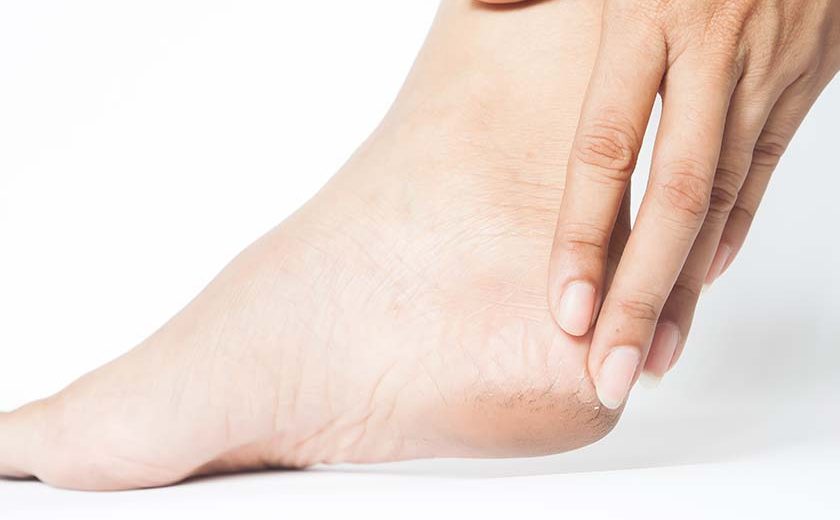Cracked heels can result from any number of reasons. Ill fitting shoes, microbial infection of calluses, simply standing too much, or even a nutrient deficiency are all possible culprits.
No matter the cause, these fissures in the epidermis are often both unsightly and painful to bear. Some of these remedies will help to heal and soothe cracked heels the natural way.
1. Better Fitting Shoes
Especially for people who do a lot of walking as part of their day-to-day routine, proper-fitting footwear is vital. When feet move around inside their shoes, friction between the heel and sole cause calluses which can easily lead to infection and cracking. When choosing shoes for work or any other step-intensive activity, make sure they fit snug around the heel with just a small amount of wiggle room in the toe. Not only will this help to prevent calluses and cracked heels, shoes that fit right will also keep feet from getting as sore during your daily activities.
2. Evaluate Your Diet
Inadequate amounts of zinc, essential fatty-acids, and vitamin D3 can all lead to cracked heels.
- Zinc
Getting your daily recommended intake of zinc is vital to numerous metabolic processes and over one hundred enzymatic reactions in the human body. Protein synthesis, regulation of carbon-dioxide in the blood stream, gene expression, apoptosis, and cell metabolism are some of the most important of these functions. If an analysis of your diet points to a zinc deficiency, eat more foods like oysters, beef, and crab which are all high in zinc content. Vegetarians can consume beans, nuts, yogurt, and fortified cereals to boost the body’s healing power with zinc. - Omega-3
Mainly recognised for their ability to increase cardiovascular health, Omega-3 fatty acids are also essential for healthy skin. Adequate intake of these ‘good fats’ can help to strengthen skin cell membranes, simultaneously improving the body’s ability to heal, defend against infection, and expel toxins. Wild-caught cold water fish such as mackerel, tuna, and sardines are all excellent sources of Omega-3 fatty-acids. Vegetarian sources include flax, chia, perilla and lingonberry. - Vitamin-D3
Also commonly known as the ‘sunshine vitamin’ for our skin’s ability to synthesise it from sun exposure, vitamin D3 is another crucial component in the fight against cracked heels. Vitamin D3 or cholecalciferol is a fat-soluble compound which is necessary for the absorption of several other nutrients in the intestines (zinc being one of them.) While safe sun exposure is the recommended method for getting your daily dose of D3, this vital nutrient may also be obtained from a supplement or in small amounts from consuming fatty fish, beef liver, egg yolks, and some vitamin-fortified foods.
(Please consult with a doctor before making changes to any prescribed diet or supplement plan.)
3. Exfoliating Scrub
To reduce the severity and pain of cracked heels, try removing the surrounding calluses with an exfoliating foot scrub made by mixing five parts ground rice or coarse rice flour with one part honey and one/two parts apple cider vinegar. Add almond or olive oil until the consistency of your scrub is that of a thick paste. Apply to calluses after a bath or shower. Alternately, you can soak feet in warm water fortified with a half cup of apple cider vinegar for ten minutes, then use a foot scrub or pumice stone for a similar effect.
4. Healing Foot Mask
Enzymes naturally present in some fruits can also help to remove dead skin, fight fungal infection, and heal your heels. Fruits which are useful for this purpose include bananas, papayas, pineapple, and avocado. Slice or mash any of these fruits and rub the exposed flesh onto damaged skin, or create a healing foot mask using a combination of said fruits and an oil such as almond, olive, jojoba, or coconut.
5. Tea Tree Treatment
Tea tree oil is a multifunctional and incredibly useful natural remedy for a long list of dermatological ailments including fungal and microbial infections of the skin. Apply tea tree oil to cracked heels at night before bed to use this extraordinary natural remedy to best effect.
(Keep in mind that tea tree oil is harsh and use caution when applying this topical remedy around raw skin or open wounds. Also, be sure to read the associated warnings and precautions before using this product).
6. Lemon and Olive Oil
Alpha-hydroxy citric acid in lemon juice can be used to break the molecular bonds between dead skin and the live cells underneath. To remove calluses and reduce the severity of cracks in heels, rub the fleshy inside of a fresh lemon rind on damaged areas or create a foot moisturiser with lemon juice and olive oil to use in the evenings before bed. Do this daily for at least ten minutes or allow lemon and oil to soak in overnight. Wear a pair of wool socks to seal in moisturizers while sleeping.
7. Avoid Hot Water
While you may enjoy the heat sensation of a long, hot bath at the end of the day, exposure to hot water actually dries out your skin and can make cracked heels even worse. To help remedy this problem, bathe in warm water only. Add organic oils or Epsom salts to your bath to nourish damaged skin. After your bath or shower, pat yourself dry instead of rubbing to prevent further damage to already irritated skin. Finally, apply moisturisers to cracked heels immediately after bathing for best effect.
8. Coconut Oil
Proponents of coconut oil will tell you that there is no better moisturiser for your skin. Full of nutrients and healthy fatty acids, coconut oil soaks in fast and provides deep and lasting moisture. As an added benefit, fatty acids in coconut oil also have anti-microbial properties which can further soothe irritation caused by infection in cracked heels. Apply cold-pressed or wet-milled coconut oil to dry and damaged areas and let it soak in overnight.


